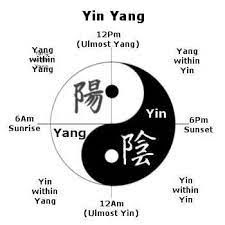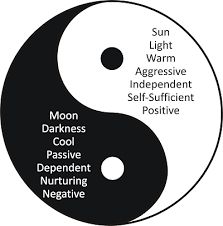Yin Yang Theory: The Foundation of Chinese Medicine
- Erika Hawley L.Ac, MSAOM

- Mar 8, 2023
- 5 min read
The Yin Yang theory is a fundamental concept in Chinese medicine, offering the core tenets of how to balance the often conflicting forces of life.
Understanding the Yin Yang Theory is an essential part of life. A wonderful foundation for anyone interested in exploring the nature of our bodies and life from an energetic perspective, interconnected perspective.
This theory serves as the foundational idea behind many of the healing modalities and treatments used within this ancient form of medicine. It provides wisdom on how to maintain balance and health, while also providing insight into personal growth and development.
By understanding Yin Yang principles, we can gain a deeper appreciation for our own physical and mental well-being, as well as gaining an understanding of our purpose in life.
In this blog post, we explore the origins and history of this theory and its relevance to modern day health and wellness practices.
Introduction to the Yin Yang Theory

The Yin Yang theory is one of the most fundamental theories in Chinese Medicine. It dates back 2500+ years and is based on the belief that everything in the universe is made up of two opposing and complementary forces: Yin and Yang. These two forces are in constant interaction with each other, and they create everything that exists in the universe...
Yin and Yang forms of Qi (pronounced "yaaang" and "cheee") are not just opposite sides of a coin; they are also considered to be interconnected and interdependent.
Everywhere in life we can see both Yin and Yang qualities.
For example:
- In human beings; body (Yin) and soul (Yang)
- Daytime (Yang) is when we are awake and active, while nighttime (Yin) is when we sleep and rest.
- Summer (Yang) is when the days are long and hot, while winter (Yin) is when the days are short and cold.
The 4 Relationship Aspects of Yin/Yang Qi: 1) Opposition: All things have yin and yang duality, as relative to what is being discussed. For example, when comparing the relationship of meat to vegetables, meat is yang while vegetables are yin. However within categories, yin-yang qualities are also relative, for example lamb is yang compared to chicken. 2) Inter-dependence: Yin and yang cannot exist without the other. For example, there cannot be activity (yang) without rest (yin). 3) Mutual consuming: Yin and yang are in a constant state of change for preserving balance. For example, when hot (yang) we sweat (yin) more to cool down. When cold (yin) the body shivers (yang), and too much cold (yin) consumes heat (yang).
4) Inter-transformation: Yin and yang can change into one another when the conditions are ripe. For example, day (yang) turns into night (yin), and conditions such as hypothermia and heat stroke transforming into heat and cold in their end stages.
Both yin and yang therapy take time, self-responsibility, regular treatments, and persistence of dietary and lifestyle routines in order to restore dynamic balance. The following are general guidelines to help balance yin or yang at home.
Yin Qi

Healthy yin energy is relative to adequate, good quality nourishment reserves within the body-mind, which can be readily utilized for fuel, repair, and maintenance when required.
Examples of healthy and sufficient yin: indications in joints, skin, eyes, hair, membranes, that that the body is well ‘oiled and lubricated’, able to cool down when needed, blood is healthy and nourished, and the mind is rested and calm, able to sleep peacefully.
Examples of too much yin (includes "dampness"):
Lethargy, feelings of heaviness, dullness, depression, stagnant, feeling cold, slowness, water retention, bloating, fatigue, muscle soreness, sharp or stiff pain, low sex drive, apathy, over-sleeping, foggy thinking, adrenal fatigue, hypothyroidism, digestive imbalances, food sensitivities, amenorrhea, and tumors or cysts.
Too Much Yin? Increase Yang Qi....

Yang diet therapy: Consume cooked, warmed, mildly sweet, and pungent foods that stoke digestive fire and encourage circulation in the body. Good quality yang type foods are considered sharp, warm, dry, and rough.
Avoid cool, damp foods such as raw and cold food and drink, processed foods, milk, natural and refined sugars, refined salt and overconsumption of oils; these foods hinder digestive and metabolic fire.
High doses of bitter and cold herbs, purgatives, laxatives, and over-eating injures spleen and stomach yang, while regular timed and enjoyed meals supports yang energy.
Foods to increase yang (energizing, lightening, reducing, and motivating): Ginger-rosemary tea or a cup of high quality coffee first thing in the morning, hot water, foods cooked for a long amount of time, soups and stews, beef, lamb, venison, trout, shrimp, sprouted walnut, pistachio, sprouted quinoa, sprouted pumpkin seed, scallion, rosemary, sage, cinnamon, cardamom, black pepper, ginger, and garlic.
*Yang vegetables tend to have drying and cooling energetics therefore add oil and spices. Exercise to increase yang: Keep moving throughout the day. Engage in gentle to moderate intensity exercise such as walking and strength training, dancing, rebounding, tai chi, pilates, and yoga.
Excessive physical and sexual activity consumes kidney yang. Lifestyle suggestions: Fresh air and sunshine first thing in the morning, camping in nature, applying warmth with a hot water bottle, keeping warm, listening to uplifting music, engaging in purpose and passion, creativity, self care product overhaul/detox, and taking self-responsibility. Self care therapies to compliment acupuncture such as hot stone massage, head massage, Thai and Ayurvedic massage. Excessive mental activity such as over-thinking, worrying, and over-working hinders yang energy.
Yang Qi
(pronounced "yaaang" "chee")

Healthy yang energy is relative to movement; our ability to be naturally motivated to get up and do throughout the day. It is the body’s metabolic and digestive fire and assists in physiological functioning, for example water regulation, blood circulation/warmth, and the breaking down and assimilation of food into nutrients for available energy.
Examples of healthy yang qi: doing, energizing, activating, motivating, breaking down (catabolic), higher parts of body, function, male, light, warm/hot, sun, north or east (sun rising in east), bright, moving, loud.
Examples of too much yang qi: fever, feeling hot, thirst, dark scanty urination, mania, high sex drive, rage, hyper-excitability and hyperactive, restless, high cortisol levels, foul and urgent bowel movements or constipation, dry stool, red eczema and rashes, dryness, palpitations, sleep disturbances, headaches and migraines, nausea, dizziness, tinnitus, hypertension, hard to gain weight, scattered.
Too Much Yang Qi? Increase Yin Qi!

Yin diet therapy: Consume sweet, salty, and sour real food flavors, high water content produce, quality fats and proteins, and deeply nutrient dense items to help build yin.
Avoid stimulant food and drinks such as coffee, alcohol, processed foods, extremely pungent/spicy foods, individual food sensitivities, and sugar. Regular times meals and snacks in a relaxed atmosphere and thorough chewing of food supports yin. Foods to increase yin (grounding, building, and nourishing): Vegetables and fruit, baked sweet potato, zucchini and spaghetti squash, soup purees, fish and seafood, sea vegetables, egg, ghee or butter, home-made yogurt, lemon, apple cider vinegar, mint, seeds, black sesame butter, oats, raw honey, high quality organic oils (avocado, extra virgin olive, macadamia), avocado, and coconut.
*Balance yin foods with a little spice to ease digestion, for example; baked spaghetti squash with cinnamon, and roasted vegetables with black pepper. Exercise to increase yin: Gentle movement including walking in nature, swimming, restorative yoga, and qi gong. Strength training 2 - 3 times per week and running once per week is okay for some individuals with yin deficiency. Yin lifestyle suggestions: Connecting with others, time for replenishment, rest and relaxation, gentle and loving self-talk, napping, self care product overhaul/detox, digital detox (technology break), avoid excessive air conditioning and central heating, classical music, self oil massage (abhyanga), restful vacation in nature, foot baths with epsom salt, meditation, and vipassana retreat. Self care therapies to compliment acupuncture include counseling, hypnotherapy, reflexology, and cranio-sacral therapy.

"Everything in the universe contains both yin and yang elements, but one element is usually more dominant than the other. The goal of eastern medicine is to maintain balance between yin and yang within the body.
Illness occurs when there is an imbalance between these two forces.
Therefore, treatment focuses on restoring balance rather than simply treating symptoms."
How is your Yin/Yang balance feeling right now?
Are you relating more in one category than the other?
What helps you come back into "balance"?
Let us know below! We love hearing from you :)




Comments